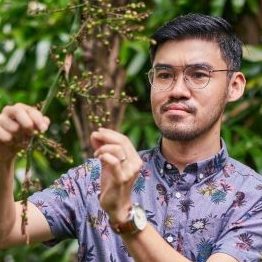
LIM JUN YING
Assistant Professor
Department of Biological Sciences
National University of Singapore
14 Science Drive 4
Singapore 117543
Plant Ecology, Evolution & Biogeography Lab
65162724
jylim@nus.edu.sg
Academic Qualifications
Ph.D. University of California Berkeley
MRes, BSc (Hons) Imperial College London
Research Areas
Community ecology, plant-animal interactions, macroevolution, macroecology, biogeography.
Research Interests
(1) Frugivory, seed dispersal and tropical forest ecology
The tropical forests of Southeast Asia are among the most diverse and productive ecosystems in the world. As animals play important roles as seed dispersers in tropical forest ecosystems, the pervasive decline of animal populations (“defaunation”) may lead to cascading negative effects on plant biodiversity, ecosystem structure and carbon storage. Defaunation may thus undermine efforts to reduce greenhouse gas emissions, avert biodiversity loss and restore degraded habitats. In Southeast Asia (SEA), defaunation from decades of overhunting and habitat degradation have reduced many areas into “empty forests”, impoverished ecosystems where only a few small-sized or resilient species remain. However, the long-term consequences of defaunation on SEA ecosystems remain poorly understood, mainly because most work has been limited to local site-based observations and has not been considered within a larger eco-evolutionary framework. To understand how defaunation may be affecting tropical ecosystems, I am interested in combining modelling (e.g., machine learning), molecular and field data to better understand how Southeast Asian seed dispersal interaction networks are structured / organized, how they have been impacted by anthropogenic pressures, and how these changes may impact forest dynamics at both local and landscape-scales.
(2) Biogeography, macroevolution and macroecology of tropical plants
Why do some areas harbour so many plant species, whereas others much less? How has the history of a clade shaped its current distribution and diversity? What is the role of chance in the evolution and distribution of plant groups? How have different tropical plant groups responded to the complex tectonic and climatic changes over the past millions of years?
The diversity of the biota of any place and time is often the product of a long and complex history of ecological and evolutionary assembly, which occurs amid a backdrop of constant abiotic and biotic change across multiple spatiotemporal scales. My lab aims to understand how this dynamism has shaped the distribution, diversity and evolutionary history of plant groups in Southeast Asia and beyond, by combining population genomics, phylogenetics, big biodiversity datasets and modelling.
Selected Publications
-
Lim, J.Y., Wasserman, M.D., Veen, J., Després-Einspenner, M.L. & Kissling, W.D. (2021) Ecological and evolutionary significance of primates’ most consumed plant families. Proceedings of the Royal Society B, 288, 20210737.
-
Song, X., Lim, J.Y., Yang, J. & Luskin, M.S. (2021) When do Janzen-Connell effects matter? A phylogenetic meta-analysis of conspecific negative distance and density dependence experiments. Ecology Letters, 24, 608–620.
-
Lim, J.Y., Svenning, J.C., Göldel, B, Faurby, S. & Kissling, W.D. (2020) Frugivore-fruit size relationships between palms and mammals reveal past and future defaunation impacts. Nature Communications, 11, 4904.
-
Krehenwinkel, H., Wolf, M., Lim, J.Y., Rominger, A.J., Simison, W.B. & Gillespie, R.G. (2017) Estimating and mitigating amplification bias in qualitative and quantitative arthropod metabarcoding. Scientific Reports, 7, 1–12.
-
Lim, J.Y. & Marshall C.R. (2017) The true tempo of evolutionary radiation and decline revealed on the Hawaiian archipelago. Nature, 543, 710–713.
-
Rominger, A.J., Goodman, K.R., Lim, J.Y., Armstrong, E.E., Becking, L.E., Bennett, G.M., Brewer, M.S., Cotoras, D.D., Ewing, C.P., Harte, J., Martinez, N.D., O’Grady, P.M., Percy, D.M., Price, D.K., Roderick, G.K., Shaw, K.L., Valdovinos, F.S., Gruner, D.S. & Gillespie, R.G. (2016) Community assembly on isolated islands: macroecology meets evolution. Global Ecology and Biogeography, 25, 769–780.
-
Lim, J.Y., Fine, P.V.A. & Mittelbach, G.G. (2015) Assessing the latitudinal gradient in herbivory. Global Ecology and Biogeography, 24, 1106–1112.
